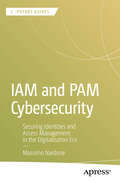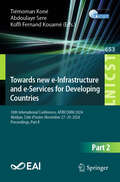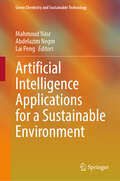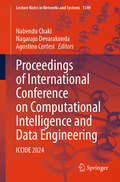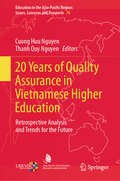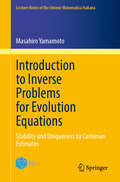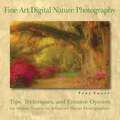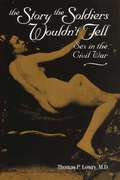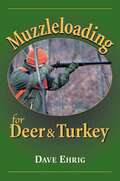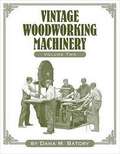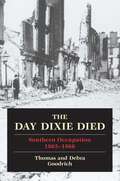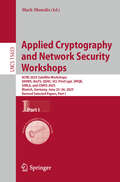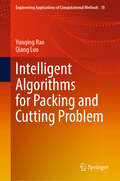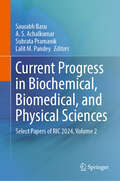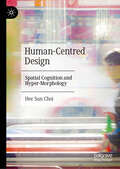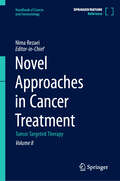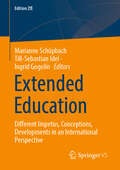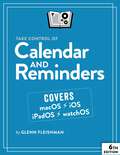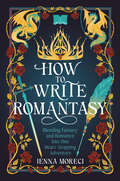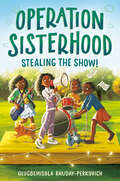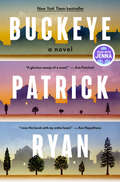- Table View
- List View
IAM and PAM Cybersecurity: Securing Identities and Access Management in the Digitalization Era (Apress Pocket Guides)
by Massimo NardoneIn today&’s digital age, organizations face growing cyber threats targeting user identities and access credentials. Identity and Access Management (IAM) helps secure identities, manage privileges, and enforce security policies—making it essential for zero-trust security, compliance, and efficiency. Privileged Access Management (PAM), a specialized branch of IAM, focuses on protecting and monitoring privileged accounts such as administrators, root users, and service accounts. Because these accounts have elevated access, they are prime targets for cyberattacks. Together, IAM and PAM safeguard access to systems, applications, and data, playing a vital role in cloud security, IoT, and enterprise environments by preventing unauthorized access and mitigating insider threats. Readers will learn: · Why securing identities is critical today · <span lang="EN-IN" style="font-size: 11.0pt; font-family: 'Calibri',sans-serif; mso-ascii-theme-font: minor-latin; mso-fareast-font-family: Calibri; mso-fareast-theme-font: minor-latin; mso-hansi-theme-font: minor
Towards New e-Infrastructure and e-Services for Developing Countries: 16th International Conference, AFRICOMM 2024, Abidjan, Côte d’Ivoire, November 27–29, 2024, Proceedings, Part II (Lecture Notes of the Institute for Computer Sciences, Social Informatics and Telecommunications Engineering #653)
by Abdoulaye Sere Tiémoman Koné Koffi Fernand KouaméThis two-volume set LNICST652-653 constitutes the refereed proceedings of the EAI 16th International Conference on International Conference on Towards new e-Infrastructure and e-Services for Developing Countries, AFRICOMM 2024, which took place in Abidjan, Côte d&’Ivoire, in November 2024.The 52 full papers presented in this volume were carefully reviewed and selected from 130 submissions. They are organised in the following topics: Part I : E- Government AND E-Service; Emerging Network; and Cybersecurity.Part II : Big Data Analytic, Blockchain / Workshop - Emerging Tehnologies / PHD; Artificial Intelligence and Machine Learning Applications.
Artificial Intelligence Applications for a Sustainable Environment (Green Chemistry and Sustainable Technology)
by Abdelazim Negm Mahmoud Nasr Lai PengThis book explores the applications of artificial intelligence (AI) in environmental protection, with a focus on pollution monitoring and mitigation. Offering an authoritative perspective on circular and green economies through strategic AI deployment, it covers topics like risk management for human health impacts, optimization of water engineering processes, and real-time monitoring for contamination detection. Particular attention is given to water-quality-related concerns and optimizing operational parameters critical for wastewater treatment. In this book, readers will discover how AI is applied for early warning systems, detecting potential contamination in aquatic, terrestrial, and atmospheric environments. Expert contributors discuss the integration of AI with environmental sustainability, the Internet of Things (IoT), machine learning, and automated monitoring techniques. The book also highlights the role of AI-supported low-cost smart sensors in environmental monitoring and climate change mitigation. Other key topics include intelligent control systems for wireless monitoring of waste management in green cities and AI's potential in diagnosing, managing, and forecasting air-pollution-related diseases for atmospheric sustainability. The book concludes with recommendations for maintaining a circular and green economy. Given its breadth, this book is an indispensable resource for researchers, scholars, and practitioners interested in understanding the transformative role of AI in environmental engineering and its contribution to sustainable development.
Proceedings of International Conference on Computational Intelligence and Data Engineering: ICCIDE 2024 (Lecture Notes in Networks and Systems #1349)
by Nabendu Chaki Agostino Cortesi Nagaraju DevarakondaThis book is a collection of high-quality research work on cutting-edge technologies and the most-happening areas of computational intelligence and data engineering. It includes selected papers from the International Conference on Computational Intelligence and Data Engineering (ICCIDE 2024). It covers various topics, including collective intelligence, intelligent transportation systems, fuzzy systems, Bayesian networks, ant colony optimization, data privacy and security, data mining, data warehousing, big data analytics, cloud computing, natural language processing, swarm intelligence, and speech processing.
20 Years of Quality Assurance in Vietnamese Higher Education: Retrospective Analysis and Trends for the Future (Education in the Asia-Pacific Region: Issues, Concerns and Prospects #76)
by Cuong Huu Nguyen Thanh Quy NguyenThis book investigates the achievements and challenges in policy and practice of Vietnamese higher education quality assurance. It also discusses the future directions and trends for the development of higher education quality assurance in Vietnam. The book is divided into five parts that address key issues of the 20-year development of Vietnam&’s quality assurance. The first part focuses on the quality assurance and higher education government in Vietnam. The second part discusses quality assurance in regional universities and national universities in Vietnam. The third part highlights stakeholders&’ engagement in quality assurance with students, academic staff, and employers. The fourth part analyzes current trends in quality assurance including the application of ICT in quality assurance, quality assurance of online and blended learning, internationalization of quality assurance, quality assurance of joint programs, and quality assurance and employability. The final part outlines the future of Vietnam&’s quality assurance that focuses on research on quality assurance, quality assurance in the news, and outlook for the future of Vietnamese quality assurance.
Introduction to Inverse Problems for Evolution Equations: Stability and Uniqueness by Carleman Estimates (Lecture Notes of the Unione Matematica Italiana #29)
by Masahiro YamamotoAmong several main formulations, the book treats inverse problems with single measurements by Carleman estimates and describes a method for proving the uniqueness and the stability for the first-order transport equations, parabolic equations, and hyperbolic equations. The book gives self-contained derivations of Carleman estimates, which do not rely on any general theory and simplified application method of the Carleman estimates to the inverse problems. Thus, the target audience is graduate students of faculty of sciences and interested graduate students from engineering fields. The book tries to limit the preliminary knowledge to a standard 4-year undergraduate course. In order to master the methodology, we restrict equations within first-order transport equations, parabolic equations and hyperbolic equations, but it is expected to apply the same methods for other evolution equations such as fluid dynamics.
Fine Art Digital Nature Photography
by Tony SweetThe latest digital photography techniques explained in concise detail. Includes more than 40 before-and-after photographs enhanced with digital techniques. Software screen captures illustrate how to adjust images for optimal results.
Story the Soldiers Wouldn't Tell
by Thomas P. LowryFirst book to cover all aspects of sexuality during the Civil War. Based on area original sources, including the soldiers' jokes, songs, letters, and diaries.
Muzzleloading for Deer & Turkey
by Dave EhrigThe definitive handbook on hunting with black powder, with specific techniques for taking deer and turkey. Covers all types of guns, from flintlocks and breechloaders to modern in-line muzzleloaders and gives expert advice on sighting, cleaning, and loading your gun. Guidelines for storing and transporting guns, powder, and ammunition safely.
Basic Leathercrafting (How To Basics)
by Elizabeth LetcavageStep-by-step instructions and photos illustrate basic leathercrafting techniques: choosing leather, stamping and decorating, stitching and lacing, and finishing.
Vintage Woodworking Machinery
by Dana Martin BatoryHere is the second volume in Dana Batory?s series of guides to the major woodworking machinery manufacturers of the 19th and 20th centuries. Covered in this volume are Parks Machine Co., the Boice-Crane Co., Baxter D. Whitney & Son, and Crescent Machine Co. All these manufacturers built a full line of woodworking machines, but most became especially known for a particular group, e.g., Boice-Crane produced medium size and capacity machines that were ideal for home shops, school shops and small business woodworkers; Whitney was famous for its thickness planers and spindle shapers, as well as for a large collection of cooperage machines; and Crescent won renown for its bandsaws and table saws, and for its Universal Wood-Worker, a combination machine. As in his first volume, the author provides a history of each manufacturer, as well as a description of the evolution of its product lines over the years. Accompanying the histories are many illustrations taken from the catalogs of the period. This is a mine of information about old woodworking machines and the companies that made them.
Through Blood & Fire
by Mark Nesbit Joshua Lawrence Chamberlain• Includes all of Chamberlain's known wartime letters• Shows his transformation from college professor to major general• Original writings placed into context by historian Mark NesbittIn July 1862 Joshua Chamberlain, a family man and respected professor at Bowdoin College in Maine, joined the fight to preserve the Union. His wartime service was exemplary; he is perhaps best remembered for his outstanding leadership at Gettysburg. At all times, however, he fought bravely and well, even at Petersburg in 1864 where he received the wound that was to torment him until his death in 1914.Throughout his time in the field, Chamberlain wrote letters of recommendation to his superiors, letters of condolence to the families of soldiers killed while under his command, and letters to his family at home. All are well written, revealing the professor's educated background and elegant prose. Nesbitt's notes set the scene, place Chamberlain's writings within the larger context of the war, and make clear the General's sterling character and his sacrifices for the country he loved.
Day Dixie Died: The Occupied South, 1865-1866
by Thomas Goodrich Debra GoodrichAs the North celebrated the end of the Civil War, the people of the South, particularly of recently fallen Richmond, mourned. The South was about to enter a period of extreme turmoil reconstruction. The Union, though preserved, would not easily be healed. Starting with Lincoln's assassination and continuing up through the harsh realities of occupation through the summer of 1866, authors Thomas and Debra Goodrich trace the history of reconstruction in the south-the death, destruction, crime, starvation, exile, and anarchy that pervaded those grim years.
American GI in Europe in World War II The Battle in France
by H. W. Kaufmann J. E. KaufmannFirsthand accounts and contextual narrative chronicling the war in Europe after D-Day. Sidebars on glider operations, rear-area activities, hedgerow country, and more. Based on interviews with more than 200 veterans.
Applied Cryptography and Network Security Workshops: ACNS 2025 Satellite Workshops: AIHWS, AIoTS, QSHC, SCI, PrivCrypt, SPIQE, SiMLA, and CIMSS 2025, Munich, Germany, June 23–26, 2025, Revised Selected Papers, Part I (Lecture Notes in Computer Science #15653)
by Mark ManulisThis three-volume set LNCS constitutes the proceedings of several Satellite Workshops held in parallel with the 23rd International Conference on Applied Cryptography and Network Security, ACNS 2025, held in Munich, during June 2025. The 43 full papers and 9 poster papers presented in this volume were carefully reviewed and selected from 87 submissions. They stem from the following workshops: · 6th ACNS Workshop on Artificial Intelligence in Hardware Security (AIHWS 2025) · 7th ACNS Workshop on Artificial Intelligence and Industrial Internet-of-Things Security (AIoTS 2025) · First Workshop on Quantum-Safe Hybrid Cryptography (QSHC 2025) · 6th ACNS Workshop on Secure Cryptographic Implementation (SCI 2025) <sp
Intelligent Algorithms for Packing and Cutting Problem (Engineering Applications of Computational Methods #10)
by Yunqing Rao Qiang LuoThis book investigates in detail the two-dimensional packing and cutting problems in the field of operations research and management science. It introduces the mathematical models and intelligent solving algorithms for these problems, as well as their engineering applications. Most intelligent methods reported in this book have already been applied in reality, which can provide reference for the engineers. The presented novel methods for the two-dimensional packing problem provide a new way to solve the problem for researchers interested in operations research or computer science. This book also introduces three new variants of packing problems and their solving methods, which offer a different research direction. The book is intended for undergraduate and graduate students who are interested in the solving methods for packing and cutting problems, researchers investigating the application of intelligent algorithms, scientists studying the theory of the operations research and CAM software developers working on integration of packing and cutting problem.
Current Progress in Biochemical, Biomedical, and Physical Sciences: Select Papers of RIC 2024, Volume 2
by Lalit M. Pandey Saurabh Basu A. S. Achalkumar Subrata PramanikThis book presents the proceedings of the 9th edition of Research and Industrial Conclave (RIC 2024) held at the Indian Institute of Technology (IIT) Guwahati, from 9 to 11 August 2024. It features a diverse collection of peer-reviewed research articles, highlighting emerging trends and application-oriented studies across a broad spectrum of science and technology domains. Broadly, this book features research in Chemistry, Physics, Biosciences and Bioengineering, and Biomedical and Health Sciences, capturing the diversity and depth of interdisciplinary exploration. It captures the essence of modern interdisciplinary research and aims to inspire further investigation and collaboration among researchers, academicians, and industry professionals. The contributions in this book is of particular interest to scholars, early-career researchers, and professionals in the fields of applied sciences, engineering, biomedical innovation, materials research, and computational healthcare technologies.
Human-Centred Design: Spatial Cognition and Hyper-Morphology
by Hee Sun ChoiThis book discusses how people experience and inhabit high-density and high-rise urban environments, drawing on current literature about the psychological, physical, and environmental health impacts. It brings a novel exploration of the evolving definitions of space and new ways of socializing within vertical urban settings, coupled with a cutting-edge approach focused on applying neuroscience principles to urban design. International case studies from Singapore, Seoul, and Hong Kong convey useful lessons for the urban design and morphology of high-density cities.
Novel Approaches in Cancer Treatment: Tumor Targeted Therapy (Handbook of Cancer and Immunology #8)
by Nima RezaeiThe rapid flow of studies in the field of cancer and immunology during the last decades has increased our understanding of the interactions between the immune system and cancerous cells. In particular, it has been well-known that such interactions result in the induction of epigenetic changes in cancerous cells and the selection of less immunogenic clones as well as alterations in immune responses. Understanding the crosstalk between nascent transformed cells and cells of the immune system has led to the development of combinatorial immunotherapeutic strategies to combat cancer. The Handbook of Cancer and Immunology offers a comprehensive and up-to-date review of cancer immunology and immunotherapy, emphasizing key findings and clinically relevant data. This reference work is an essential resource for researchers, students, academics, and clinicians committed to advancing knowledge, diagnostics, and treatments in this vital field.
Extended Education: Different Impetus, Conceptions, Developments in an International Perspective (Edition ZfE #18)
by Marianne Schüpbach Till-Sebastian Idel Ingrid GogolinIn many societies today, there has been an increase in out-of-school time education, extended education, for children and adolescents. Extended education is a field that has been growing rapidly in recent years. This issue provides an overview of developments in various countries around the world. Theoretical considerations on similarities and differences between the processes are combined with empirical data. Extended Education as an umbrella term is discussed. The contributions show (1) an overview over the field, (2) different forms of institutionalization, learning outcomes, effects on the reduction of social inequality and social risks in growing up and on the well-being of children (country case studies) and (3) comparison between different countries in its development. Chapter [Extended Education – Different Impetus, Conceptions, and Developments in an International Perspective. An Overview] and Chapter [Extended Education in Primary Education Across Different National Contexts: Developing an Approach for Categorising Educational Foci] are licensed under the terms of the Creative Commons Attribution 4.0 International License (https://creativecommons.org/licenses/by-nc-nd/4.0/). For further details see license information in the chapter.
Take Control of Calendar and Reminders
by Glenn FleishmanLearn how to unlock the full potential of Apple’s Calendar and Reminders! In Take Control of Calendar and Reminders, Mac experts Scholle McFarland and Glenn Fleishman help you get the most out of these apps, showing you how to customize them, sync data across devices, and share meeting invitations and reminder lists. You’ll also learn how to use Siri as a shortcut, and how to fix common problems.
Take Control of Apple TV
by Glenn FleishmanWhether you're considering an Apple TV or you already have one, you can fully master Apple's living room device with this ultimate guide by Josh Centers. You'll learn how to set it up and use it to watch movies and TV shows, play music, display photo slideshows, give presentations, and access all manner of apps on the big screen.
How to Write Romantasy: Blending Fantasy and Romance into One Heart-Stopping Adventure
by Jenna MoreciLearn the craft of creating a page-turning romantasy novel in this easy-to-follow guide from writing expert and renowned author of The Savior&’s Series, Jenna Moreci.In How to Write Romantasy, Moreci takes you from your first kernel of inspiration through the resolution of your novel, ensuring you hit all the key elements along the way. Chapters are organized around specific plot points, necessary skills, and common questions, covering topics such as building a fantasy framework, creating compelling characters, learning the art of the tease, and bringing home the happily ever after. Each chapter is followed by a summary that you can use for quick reference. You will learn:• How to marry the fantasy plot with the romantic storyline• How to write a marketable book that romantasy readers will love• How to create a shippable pairing that makes fans swoon• How to build romantic and physical chemistry• How to pace the story if you&’re writing a seriesDelivered with a hefty dose of humor, Moreci&’s clear and simple methods are accessible for writers of all experience levels. With How to Write Romantasy, you will walk away with a deeper understanding of the genre and plenty of inspiration to build your very own romantasy novel.
Operation Sisterhood: Stealing the Show!
by Olugbemisola Rhuday-PerkovichThe Operation Sisterhood series continues as the four sisters decide to put on a community musical! The creative sister Sunday is the director and writer, but she has lost her spark. Can she find her shine again before everyone calls it quits?"This ode to Black girlhood and the communities that serve them offers humor, tenderness, and charm." –Renée Watson, New York Times bestselling authorSisters Sunday, Bo, Lee, and Lil are four sisters from a patchwork family. Bonded by their love of music, these sisters formed a musical babysitting band business Operation Sisterhood that just planned the best garden wedding party their Harlem community has seen. Imaginative Sunday impulsively announces her next big community project—staging an original musical—everybody&’s counting on her, especially her sisters, Bo and the Twins, Lil and Lee. Then, disaster: Sunday has lost her creative mojo just when she most want to impress her new neighbor, TV star Talitha Thomas. Soon there will be more drama offstage than on!Can Bo and the Twins use what they learn about New York City communities past and present and their band babysitting business to help Sunday find her shine and her love of storytelling again? It&’s Operation Sisterhood to the rescue!Award-winning author Olugbemisola Rhuday-Perkovich delivers a heartwarming sequel to Operation Sisterhood. Includes a New York City map to follow along on the sisters' journey!
Buckeye: A Novel
by Patrick RyanNEW YORK TIMES BESTSELLER • READ WITH JENNA BOOK CLUB PICK AS FEATURED ON TODAY • A &“mesmerizing&” (People) novel that weaves the intimate lives of two midwestern families across generations, from World War II to the late twentieth century.&“A glorious sweep of a novel.&”—Ann Patchett&“Captivating.&”—The New York Times Book Review&“A once-in-a-decade novel . . . I fell in love with these characters.&”—Jenna Bush HagerOne town. Two families. A secret that changes everything.In Bonhomie, Ohio, a stolen moment of passion, sparked in the exuberant aftermath of the Allied victory in Europe, binds Cal Jenkins, a man wounded not in war but by his inability to serve in it, to Margaret Salt, a woman trying to obscure her past. Cal&’s wife, Becky, has a spiritual gift: She is a seer who can conjure the dead, helping families connect with those they&’ve lost. Margaret&’s husband, Felix, is serving on a Navy cargo ship, out of harm&’s way—until a telegram suggests that the unthinkable might have happened.Later, as the country reconstructs in the postwar boom, a secret grows in Bonhomie—but nothing stays buried forever in a small town. Against the backdrop of some of the most transformative decades in modern America, the consequences of that long-ago encounter ripple through the next generation of both families, compelling them to reexamine who they thought they were and what the future might hold.Sweeping yet intimate, rich with piercing observation and the warmth that comes from profound understanding of the human spirit, Buckeye captures the universal longing for love and for goodness.
